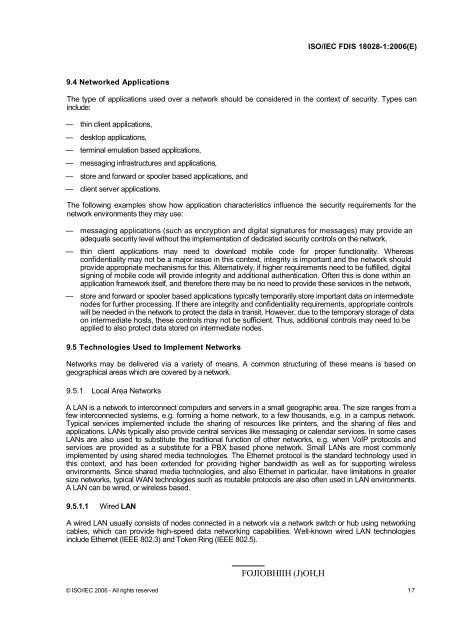INTERNATIONAL ISO/IEC STANDARD 18028-1
INTERNATIONAL ISO/IEC STANDARD 18028-1
INTERNATIONAL ISO/IEC STANDARD 18028-1
- No tags were found...
You also want an ePaper? Increase the reach of your titles
YUMPU automatically turns print PDFs into web optimized ePapers that Google loves.
<strong>ISO</strong>/<strong>IEC</strong> FDIS <strong>18028</strong>-1:2006(E)9.4 Networked ApplicationsThe type of applications used over a network should be considered in the context of security. Types caninclude:— thin client applications,— desktop applications,— terminal emulation based applications,— messaging infrastructures and applications,— store and forward or spooler based applications, and— client server applications.The following examples show how application characteristics influence the security requirements for thenetwork environments they may use:— messaging applications (such as encryption and digital signatures for messages) may provide anadequate security level without the implementation of dedicated security controls on the network,— thin client applications may need to download mobile code for proper functionality. Whereasconfidentiality may not be a major issue in this context, integrity is important and the network shouldprovide appropriate mechanisms for this. Alternatively, if higher requirements need to be fulfilled, digitalsigning of mobile code will provide integrity and additional authentication. Often this is done within anapplication framework itself, and therefore there may be no need to provide these services in the network,— store and forward or spooler based applications typically temporarily store important data on intermediatenodes for further processing. If there are integrity and confidentiality requirements, appropriate controlswill be needed in the network to protect the data in transit. However, due to the temporary storage of dataon intermediate hosts, these controls may not be sufficient. Thus, additional controls may need to beapplied to also protect data stored on intermediate nodes.9.5 Technologies Used to Implement NetworksNetworks may be delivered via a variety of means. A common structuring of these means is based ongeographical areas which are covered by a network.9.5.1 Local Area NetworksA LAN is a network to interconnect computers and servers in a small geographic area. The size ranges from afew interconnected systems, e.g. forming a home network, to a few thousands, e.g. in a campus network.Typical services implemented include the sharing of resources like printers, and the sharing of files andapplications. LANs typically also provide central services like messaging or calendar services. In some casesLANs are also used to substitute the traditional function of other networks, e.g. when VoIP protocols andservices are provided as a substitute for a PBX based phone network. Small LANs are most commonlyimplemented by using shared media technologies. The Ethernet protocol is the standard technology used inthis context, and has been extended for providing higher bandwidth as well as for supporting wirelessenvironments. Since shared media technologies, and also Ethernet in particular, have limitations in greatersize networks, typical WAN technologies such as routable protocols are also often used in LAN environments.A LAN can be wired, or wireless based.9.5.1.1 Wired LANA wired LAN usually consists of nodes connected in a network via a network switch or hub using networkingcables, which can provide high-speed data networking capabilities. Well-known wired LAN technologiesinclude Ethernet (IEEE 802.3) and Token Ring (IEEE 802.5).FOJIOBHIIH (J)OH,H© <strong>ISO</strong>/<strong>IEC</strong> 2006 - All rights reserved 17
















